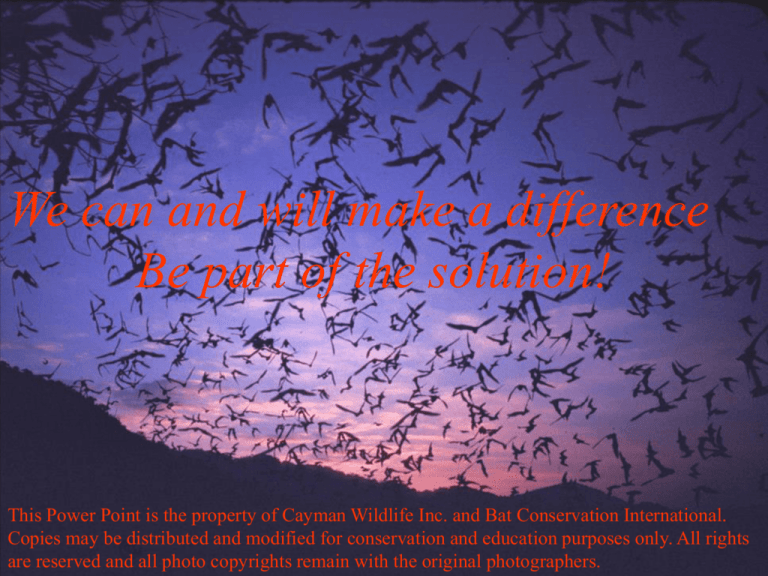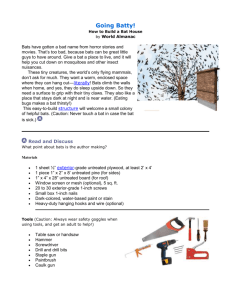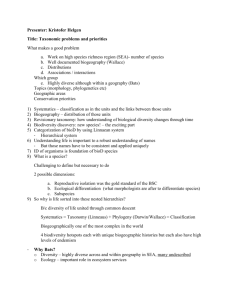
We can and will make a difference
Be part of the solution!
This Power Point is the property of Cayman Wildlife Inc. and Bat Conservation International.
Copies may be distributed and modified for conservation and education purposes only. All rights
are reserved and all photo copyrights remain with the original photographers.
www.caymanwildlife.org
Bats and Bat Houses
in the Cayman Islands
Conservation Ideas for the Caribbean and the Tropics
Presentation compiled
by
Lois Blumenthal
Director of the
Bat Conservation Program
National Trust for the Cayman Islands
Caribbean Coordinator for
Bat Conservation International
Director of
Cayman Wildlife Connection
There are over 1,150 bat species worldwide.
They come in all shapes and sizes.
They are all VERY different!
Some are tiny. This bumblebee bat found
only in Thailand weighs less than a penny.
Some are large and have a 6-foot wing span.
Some look
very strange!
Some are handsome.
Some are glamorous.
But
not
everyone
can be
beautiful.
There is a reason they look the way they do.
Strange features have a purpose.
Each
species is
adapted
to
survive.
Some bats use suction cups to cling to a leaf.
Some have
eyes inside
their ears!
Spotted Bats roll up their ears to sleep.
Yellow-winged Bats live in Africa.
Some bats
show-off
for the
girls.
All bats can see. Even this one!
Huge ears help bats hear ultrasonic sounds.
Bats use echoes to find insects in the dark.
This is called echolocation.
The sound is very loud so the bat can
hear the echo of a tiny bug.
Each species eats
something different.
Bats can share
habitat without
competing.
Some bats eat scorpions!
This bat can hear the footsteps of a beetle
up to 16 feet away!
Frog-eating Bat of South America
Fish-eating Bats have huge feet for
catching minnows.
The Fish-eating Bat lives in Jamaica, but
not in the Cayman Islands.
The Vampire Bat is NOT in Cayman.
This Vampire Bat is drinking the blood of a
sleeping chicken.
A drug for treating heart disease was
discovered by studying Vampire Bat saliva.
Bats pose no
danger to people.
This Flying Fox
loves to eat figs.
Tent-making Bats of Central America
Tent-making Bats asleep in the jungle
The Tent-making Bat has a “nose-leaf.”
It echo-locates through its nose.
Bonneted Bat of Jamaica
Bats are
NOT
flying
mice.
Bats are in the Family Chiroptera
which means “Hand-Wing.”
Bats Support a Healthy Ecosystem:
through
Insect Control
Pollination
Seed Dispersal
A Single Bat Can Eat More Than
1,000 Bugs in One Hour!
The Velvety Free-tailed Bat
is often found in roofs.
Common species like these are the
“Workhorses” in the ecosystem.
Their large numbers mean they have a
major effect on the insect populations.
Your Grocery Budget!
Prices would rise without bats!
Bats’ value to agricultural insect
control in the United States alone is
estimated at $22.9 billion yearly.
(2011 Report)
Rare
Endemic
Big
Brown
Bat
This species is also found in roofs.
Bats in the roof are only sleeping.
Bats try to hide from people.
Bats do not damage the house.
But guano builds up inside the roof.
Unfinished roof edge
Missing soffit vent
Bats use any opening.
Cayman bats look for open soffits.
This is the best method for
removing bats from roofs.
Put in a one-way door. Bats can go out –
but not back in. Pipe Must Point DOWN.
The pipe is flush with
the inside surface.
Bats can see out and
slide down.
The pipe can stay in place.
Even expensive homes can have bat problems if
an opening is not repaired promptly.
Check the entire roof first
and close all holes that
bats are NOT using.
Fascia boards
can separate
leaving a gap.
This method is not approved.
Cayman bats have learned
to crawl under netting like this.
Use foam backer rod
to fill gaps that bats are not using.
Spray Foam is NOT
recommended.
It deteriorates and
crumbles away in the
heat so bats can return.
Spray foam can also
trap bats when it is wet.
Cover the exit with a box & pipe.*
For more detailed instructions, contact info@caymanwildlife.org or look on www.caymanwildlife.org for info sheets.
If no screening is on the inside,
bats use vents to enter & exit roofs.
The design
is different
for
each
style of
vent.
The box must fit
over the attic vent.
The bats can leave through the two PVC
pipes, but cannot get back inside.
Boxes built to fit roof opening always
with downward-facing pipes
Bats can enter a
building through
holes drilled for
wires and pipes.
Let the bats fly out at
dusk.
Then close the holes
temporarily.
Re-open briefly the
next night to make
sure they are all out.*
This is the
easiest way to
cover all the
holes.
For some jobs, you need
a tall ladder
and the right tools.
Bats go into the box, down the pipe, and
can’t get back in to the roof.
A flexible hose can be used for tight corners,
but the end must always point down.
Make this with a mouse
pad and duct tape.
Hose must be smooth so
bats can not grip it and
climb inside.
ALWAYS MONITOR EXCLUSIONS!
Bats have only one baby per year.
We never remove bats during the summer.
Bat births begin in late May.
Wait for baby bats to grow up.
Get bats out after November 15
when all the young can fly.
Guano is dry and can be vacuumed away.
But, where can they go?
If bats move into another building,
the problem starts
all over again.
It’s important to provide BAT HOUSES
so bats won’t shift to your neighbor’s roof.
Bat houses give bats
a safe place to live.
North American
models are usually
put on the side
of a building
or mounted on
two slender poles.
Our design uses two standard models combined
to fit on top of utility pole like a hat.
Woodpeckers
night-roost
in the
extra spaces
beside the pole.
OR
this area can be
fitted with more
bat crevices.
We converted
some of the open
areas to bird
houses but yearly
cleaning to avoid
parasite and
fungal problems
in the bird nests
was too difficult.
SEE UPDATED
PLANS on
Cayman Wildlife Connection
Out of Date
www.caymanwildlife.org
Bird nest sections are
NO LONGER
recommended.
This double bat house will hold 500 bats.
Metal roofing is stronger
and more storm-resistant
Use ONLY PVC netting or grooved wood.
No screen, shade cloth or stucco netting.
Bats tangle and die when these stretch and
fall apart.
We use InterNet Inc
Item # XV-1348 47.5" x 100' ( Black )
7681 Setzler Parkway North
Brooklyn Park, MN 55445, USA
http://www.industrialnetting.com/bat_houses.html
Phone 1-800-328-8456 (in USA and Canada)
Phone: 763-496-6355 - Fax: 763-496-6356
E-mail: info@industrialnetting.net
Wood partitions are deeply grooved and
sealed with non-toxic thinly applied paint.
No nails or screws protruding
inside the bat house.
Exposed nails
This bat house had to be re-done.
Test model at
Marriott
Beach Resort
Grand Cayman
Bat houses from garden supply stores are
often small and of poor quality.
They don’t last long in the tropics.
A Triple-wide can hold 1,500 bats.
CUC has the Power!
The specially adapted plan
makes installation fast and easy.
(for a utility company!)
CUC putting up a bat house in Bodden Town
An out-of-the-way corner in a
parking lot is a good quiet location.
Bats need a
“swoop zone”
that is open
and clear
of obstacles for
their “fly-out”
The Cayman
Islands’ Governor
and his wife are
proud of their
bat house.
The nightly Bat “Fly-Out” at the Governor’s
House is a highlight
at official cocktail parties!
ONLY insect-eating bats
can live in bat houses.
Farmers now understand
that Fruit Bats
never
use bat houses.
On September 11, 2004 Hurricane Ivan
battered Grand Cayman with
near Category 5 winds for 34 hours.
Damage to buildings and infrastructure was
massive. Trees, plants and wildlife
suffered appalling losses.
All 40 of Grand Cayman’s
occupied bat houses stood
through Ivan with bats safely
inside.
Some bat houses are slightly
tilted now, but this
does not affect the bats.
Thousands of bats survived the storm in bat
houses. Today, over 11,000 Velvety
Free-tailed bats live in 82 bat houses.*
Bat Watching!
Tourists, students and
residents enjoy watching
an interpreted
“fly-out” at sunset.
Bat houses can also be
mounted on TV towers,
or other poles.
But they must stand
away from trees and
buildings and be at
least 16 feet above the
nearest surface.
Bat houses can be
mounted on
fencing poles.
They must be at
least 16 feet
above the ground
or underbrush.
Putting bat houses very near the roof where
bats will be excluded helps ensure success.
But, There is more to
be done.
Bat Houses
only provide
habitat
for some species
of bats.
Bats Eat
Mosquitoes
and
Garden Pests.
Some bats live only in caves and
cannot use roofs or bat houses.
Rare Flower Bats
live in Cayman Islands caves.
Big-eared Bats live in caves
and eat roaches and garden pests.
The bats from one cave in Texas
eat 250 TONS of insects nightly!
Bat cave “fly-outs” can become
Ecotourism attractions!
This bridge in Austin, Texas
is home over a million bats.
Tourists come to watch the “Fly-Out.”
Snakes eat some bats.
Owls and hawks and house-cats also eat bats.
But people pose the biggest threat.
Avoid visiting caves during
spring and early summer
when baby bats are born.
Too much disturbance
frightens mother bats away,
leaving the young bats to die.
Developers should
NEVER
fill in caves
without first
checking for bats.
In the north, bats sleep in caves during
winter. This is called hibernation.
Special gates protect hibernating bats.
White-nose Syndrome
is a devastating new problem in
North American hibernating bats.
So far, this terrible disease is
not affecting tropical bats.
Bats benefit people in
unexpected ways.
Guano mining in Thailand is a
profitable business.
Bat guano is used to
develop new fuels
and detergents.
The caves in the Cayman Islands have
never been fully studied.
Bats need protected caves to survive.
Some bats live in hollow trees.
Some live
outside the
trees.
Some live in palm trees.
Tree-dwelling bats need forests to survive.
Bats Support a Healthy Ecosystem:
through
Insect Control
Pollination
Seed Dispersal
Flower bats
pollinate
ecologically
critical plants.
Flower bats drink nectar
like hummingbirds.
This bat’s nose fits into the cactus flower.
The same bats return for the fruits.
Giant cacti rely heavily on bats for
pollination and seed dispersal.
Bats are a
Keystone Species
They are critical to
the survival of other
wildlife.
Blind cave fish survive on nutrients
brought in to caves by bats.
Bats are attracted
to large lightcolored flowers.
Some flowers release their nectar at night.
Many tropical
trees depend on
bats for
pollination.
Flower bats are
crucial to the
survival of
tropical forests.
Bats Support a Healthy Ecosystem:
through
Insect Control
Pollination
Seed Dispersal
Bats carry
fruit to
feeding
roosts.
Chewed seeds fall
to the ground.
Bats drop seeds as they fly,
while they eat,
and through their droppings.
Bats can fly over
cleared areas
that are too hot
for birds.
Seeds dropped by bats are the first
to re-colonize cleared forest land.
Many fruit trees are dependent on bats.
Cayman’s nine known species of bats
ALL Caribbean Endemic Sub-species
Caribbean Endemic Species
Found only on Caribbean Islands
White-shouldered Bat
Nectar Bat
Buffy Flower Bat
Grand Cayman’s Endemic Sub-species
Found ONLY on Grand Cayman Island
Big Brown Bat
Five Insect-eating Bats
Red Bat
Big-eared Bat
Big Brown Bat
Free-tailed Bat
Velvety Free-tailed Bat
Four Nectar, Pollen and Fruit Bats
White-shouldered Bat
Nectar Bat
Caribbean Fruit Bat
Buffy Flower Bat
Caribbean Fruit Bats in their cave
Caribbean Fruit Bat with Almond
Caribbean Fruit Bat with Allspice berry
For advice about how to protect your fruit trees
from bats, visit www.caymanwildlife.org
Your Grocery Budget!
Prices would rise without bats!
Bats’ total value to agriculture in the
United States alone is estimated at
$22.9 billion yearly.
This Caribbean Fruit Bat
has been eating a Sweetsop.
Ummm!
Sweetsop!
Picking fruit while still green
can help prevent crop damage.
Fruit bats in Guam
Fruit flies multiply on rotten fruit.
Fruit bats help control this problem.
Caribbean Fruit Bats also pollinate.
White-shouldered
Bats have been found
only
in Haiti, Cuba
Grand Cayman
and possibly
Cayman Brac.
The rare White-shouldered Bat lived in
the Lower Valley Forest in Savannah.
White-shouldered
Bats live in fig
trees.
They need healthy
native forests to
survive.
This Nectar
Bat is also a
Caribbean
endemic.
Nectar Bats live only in caves.
Buffy Flower
Bats are very
shy.
They live
only in caves.
Buffy Flower
Bat caught in a
mist-net in the
Lower Valley
Forest.
Four Nectar, Pollen and Fruit Bats
White-shouldered Bat
Nectar Bat
Caribbean Fruit Bat
Buffy Flower Bat
Five Insect-eating Bats
Red Bat
Big-eared Bat
Big Brown Bat
Free-tailed Bat
Velvety Free-tailed Bat
Mexican Free-tailed Bats eat moths, beetles
and other insects including mosquitoes.
Cayman’s
Mexican Freetailed Bats are
now rare.
Big-eared Bats fly slowly in the trees.
They eat large moths, roaches and katydids.
Big-eared
Bats live
ONLY in
caves.
This Bigeared Bat
lives in an
undiscovered
cave in
Lower Valley.
Red Bats were found for the first time
in the Cayman Islands in 2001.
Red Bats roost
alone in trees.
Red Bats have
twins.
Grand
Cayman’s
endemic
subspecies
Big Brown
Bat
Big Brown Bats are very small!
Big Brown Bat
from Cayman Brac
(shared with Cuba)
Big Brown Bat
from Grand Cayman
(smaller – darker fur)
Five Insect-eating Bats
Red Bat
Big-eared Bat
Big Brown Bat
Free-tailed Bat
Velvety Free-tailed Bat
Velvety Free-tailed Bats are
Cayman’s most common bat.
They were once called “Rat Bats” to
distinguish them from “bots” or moths.
Never touch a wild bat.
If you find a sick or injured bat or
if a bat gets into your home, call 917-BIRD
the Wildlife Hotline for help and advice.
Fallen baby bats can be rescued.
Wildlife Biologist, Annie Band
Annie uses a mist net to catch and
release bats for her research.
She mentors high school students.
Students observe and assist in the field.
Students are involved
at every level.
Dr. Ted Fleming
is a
world-famous
scientist who
studies rare bats
Bats and other
wildlife need
forests
to survive.
Ivan struck at night, and some insect-eating
species of bats were caught out in the winds.
After Hurricane
Ivan some insect
populations
exploded.
Predators like bats and birds keep insect
populations stable.
These post-Ivan
ficus leaves are
being eaten by moth
larva as soon as
they begin to grow.
Larger forests survive storms better and recover
faster than isolated trees.
Cayman’s ancient
ficus forests are
key to the survival
of rare bats
as well as
local and migrating
birds.
The beauty and
variety found in
Cayman’s native
forests is
irreplaceable.
A healthy forest has thousands of species.
Native Broadleaf
was the first to
bloom after
Hurricane Ivan and
provided the first
food for butterflies.
This slender tree is
over 100 years old.
Air plants thrive in Cayman’s forests.
Rare Ghost Orchid
Wild Banana Orchid
growing naturally in
the forest.
Cayman Islands
National Flower
Wild Banana
Orchid
Cayman Islands
National Tree
Silver Thatch Palm
Cayman
Islands
National Bird
Cayman
Parrot
Rare Zebra butterfly
Heron wading in
recovering
mangrove swamp.
A Caribbean Dove in
the Mastic Reserve.
Healthy forests need bats to survive;
and bats need forests too.
The Whiteshouldered Bat
may now be
extirpated in the
Cayman Islands
due to the loss of
fig trees in
Hurricane Ivan.
Conservation is everybody’s business.
What isn’t actively saved, will be lost.
Volunteer your time to help.
Speak to your elected representatives.
Support our programs with generous donations.
Write letters to the newspapers.
Donate funds for land purchase.
Make your garden wildlife friendly.
Visit www.nationaltrust.org.ky
www.batcon.org
www.caymanwildlife.org
www.caymanwildlife.org
Join the National Trust
Please tell others what you have learned.
Bats need help more than ever.
Cayman’s Bat Conservation
Success Story
•
•
•
•
•
•
•
•
•
•
•
•
•
www.caymanwildlife.org
Mounted over 100 large bat houses
More than 800 roof bat removals – significant public understanding & cooperation
Assisted farmers and homeowners with fruit bat problems
Stamp issue to honor Cayman Bats in 2008
Enlisted International support - Hosted visiting scientists
Gained cooperation of local pest control agencies
Initiated wildlife rescue and rehab program
Regular coverage on TV, local and international newspapers and magazines
Bat Study Guide in public school science curriculum
Slide show for schools, service clubs, public venues can be adapted regionally
Listserv www.caribbean-bats@yahoo.com
Websites: www.nationaltrust.org.ky and www.caymanwildlife.org
Facebook: Friends of Bats: Cayman Islands and the Tropics
*
Special Thanks to
Dr. Merlin Tuttle
and
Bat Conservation International
for the use of copyrighted photographs
and consistent support and guidance over many years.
Visit www.BATCON.ORG
Join BCI and support their work!
Thank You
Cathy Church
Underwater Photo Center & Gallery
for years of support and technical assistance.
www.cathychurch.com
The contribution of
Installed Utility Poles from
Caribbean Utilities Co Ltd (CUC)
is crucial to the success of the program.
The Wildlife Rescue Hot Line
donated by LIME
917-BIRD
Answered 24 - 7 - 365
for all Cayman Islands’ wild animals.
Please Join the National Trust
FOR the Cayman Islands
www.nationaltrust.org.ky
Cayman Wildlife Rescue
provides critical volunteer support.
www.caymanwildliferescue.org
Very Special Thanks to
Reid A.Weske
for bringing this PowerPoint to you
and for hosting and maintaining
www.caymanwildlife.org over many years.
Cayman Islands’ Bat Conservation Program
is also grateful for the support of :
Cayman Islands Department of Environment
Ron Moser’s Machine Shop
CGMJ and Kelly Hill of ShedWerx
The British Bat Trust
The Darwin Initiative
Additional photos by
Elaine Acker
Anne-Louise Band
Wray Banker
David Blumenthal
Janice Blumenthal
Jim Blumenthal
Lois Blumenthal
Teddy Ebanks
Michael Gore
Tansy Maki
Carla Reid
Sonny Rivers
David Wolfe
Wildlife Biologist, Ms. Anne-Louise Band
The UK Overseas Territories Conservation Forum
Photography by:
Dr. Merlin Tuttle & Mr. Courtney Platt
Drawings by Chris Mann
PowerPoint compiled by Lois Blumenthal – April 2011
Visit our website for more about Cayman
Islands bats and other wildlife and to
download the latest version of this slideshow
as well as other free educational resources.
www.caymanwildlife.org
Find us on Facebook:
Friends of Bats: Cayman Islands and the Tropics
and
Cayman Wildlife Connection
We can and will make a difference
Be part of the solution!
This Power Point is the property of Cayman Wildlife Inc. and Bat Conservation International.
Copies may be distributed and modified for conservation and education purposes only. All rights
are reserved and all photo copyrights remain with the original photographers.





